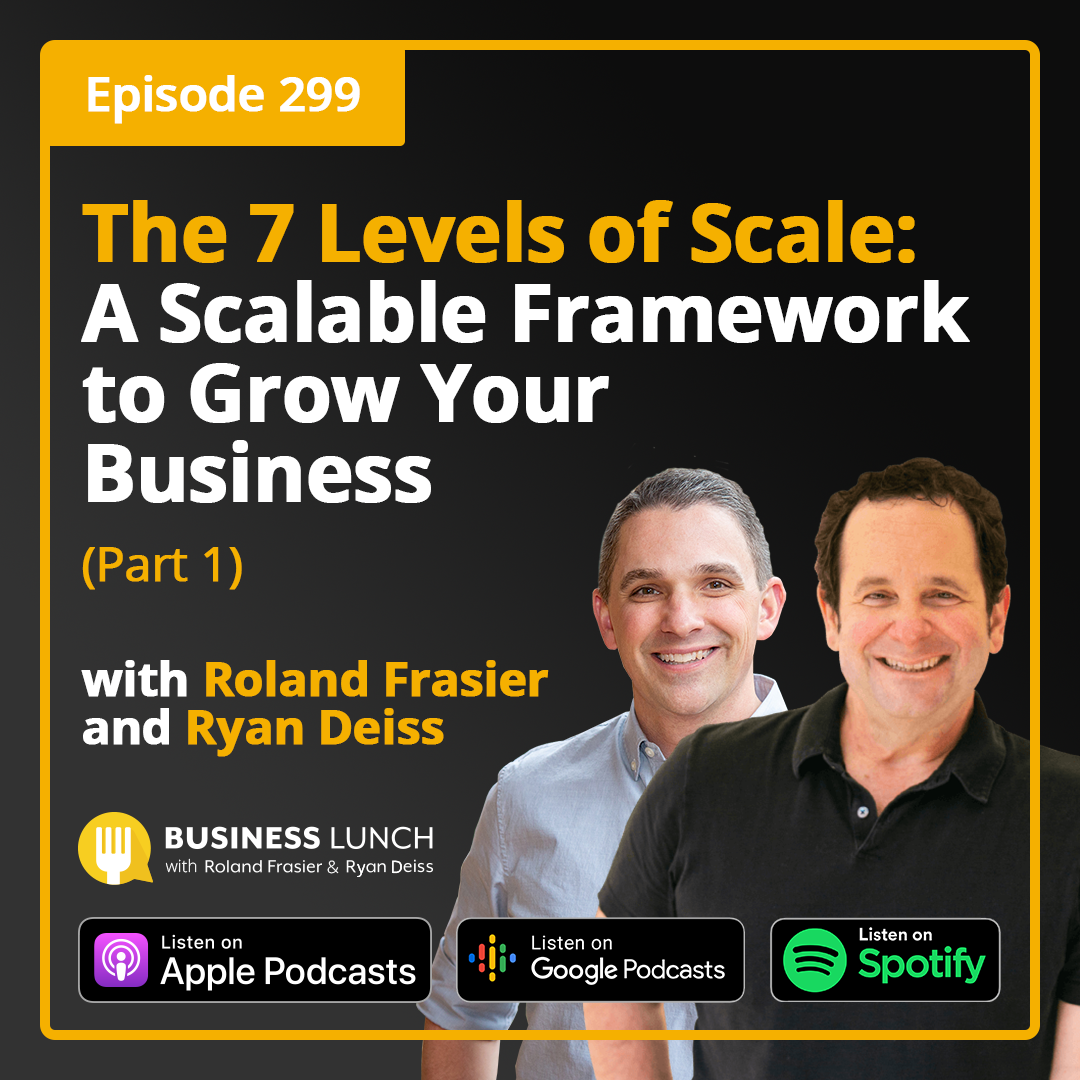Co-hosts Roland Frasier and Ryan Deiss just wrapped up their newest event, Scalable Impact Live, where they had their first opportunity to roll out a new framework they call the 7 Levels of Scale. People are always asking them, “Where do I start?” The 7 Levels of Scale answers that question.
It took a long time to develop the framework. They had all the pieces, but they needed to tie it together in a simplified way that was transferable and repeatable. In this episode, they unpack the first two levels, but here are all seven:
- Level #1: Sell and serve 10 customers.
- Level #2: Build a growth flywheel.
- Level #3: Build an upgraded scalable operating system.
- Level #4: Double your take-home pay.
- Level #5: Build your board.
- Level #6: Complete an acquisition for expansion.
- Level #7: Hit your number.
Two things to keep in mind as you work through these levels one by one. #1: Sequence matters. This is the absolute order of operations. And #2: You can’t skip a step. If you do, it won’t work.
Level #1: Sell and Serve 10 Customers
If you have not sold and served 10 unaffiliated customers, that’s the only thing you should be thinking about. Before you get business cards and a logo designed—and that’s just busy work that won’t make you money—you have to prove that people actually want what you’re selling. They want it, and they’ll buy it. And these are 10 people who aren’t your friends and family.
Nothing else matters until something is sold. But there are two phases to it. Sell and serve. Let’s say you sell 10, but you can’t deliver. Or you sell 10 people, but none of them are happy; they’re not getting what they want. You don’t have any business scaling until you’ve sold and served 10. No automation until you’ve sold and served 10. Sell and serve 10, then make a list. Congrats, high five. You’ve ascended beyond Level 1 to Level 2. Now you can think about automation.
Level #2: Build a Growth FlyWheel
Now you want to make things predictable and build a system around that. There’s a three step process for doing this: 1.) Map. 2.) Measure. 3.) Plan to improve the measurement.
Step 1: Map your growth engine. How are you going to initiate general awareness? Maybe there are multiple awareness channels. What are the biggest 2-3? Do some basic business process mapping to show the flow. At DigitalMarketer (Scalable’s sister company), they do customer value journey mapping. It’s simply mapping/documenting how customers happen from point of awareness to engagement to subscription to that initial point of conversion to ascension and delight.
Having a visual map of the journey is the first part. Step 2 is having a scorecard to show you how something is performing. Not random metrics in no particular order. No vanity metrics. Let’s say you’re buying ads on Facebook and Instagram. How do you know it’s working? Let’s track our average cost per click. Let’s track the click-through rate. And let’s track our ROAS. The scorecard shows poor, acceptable, good, awesome.
It’s color-coded, and a human goes in there each week and says, for this metric, here’s what it was and updates the status to red, yellow, or green. Doing it manually changes your perspective. When people are accountable to a metric and have to record it manually, they actually know their numbers.
Creating a growth flywheel isn’t just about putting in a lot of automations. It’s about aligning your sales and growth process—and the people who are responsible for it—toward a common objective.
Everybody agrees that this is how a customer happens. Then everybody agrees what “good” is at each stage and creates the dashboard. Then there are people responsible for each of those.
On the front end, this is how it should be—that’s the map. This is what good is—that’s the scorecard. This is how we fix it when it ain’t good—that’s the growth planning. Map, measure, plan to improve the measurement, then analyze to see if it worked.
Putting that process in place is what level 2 is all about. You need all the pieces, and you need to be consistent with it. This is the thing that gets businesses stalled out at 7 figures. Don’t be disheartened that you’re stuck at Level 2. You have a plan now. You know what to do. Do it.
Stay tuned for Part 2!
RESOURCES:
- 7 Levels of Scale (the website)
- The Customer Value Journey
- The Customer Avatar Worksheet
- ethicallyprofit.com
- getepicchallenge.com
- Scalable.Co
- The Ready to Lead podcast
- DigitalMarketer Podcast
- Perpetual Traffic podcast
OUR PARTNERS:
- Get a free proposal from Conversion Fanatics
- Get 3% cash back on your ad spend with AdCard
- Get Roland’s book, Zero Down, FREE
Roland’s EPIC Challenge.
You may have heard about Roland’s EPIC challenge, which he moved online when the Pandemic hit. It focuses on Ethical Profits In Times of Crisis and dives into no-money out-of-pocket business acquisition strategies. If you’re interested in finding out more about this strategy, click here.
Contact & Follow Roland
Through his Website.
Contact and Follow Ryan Deiss
Through his Website.

